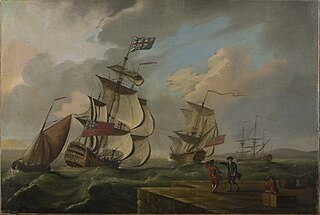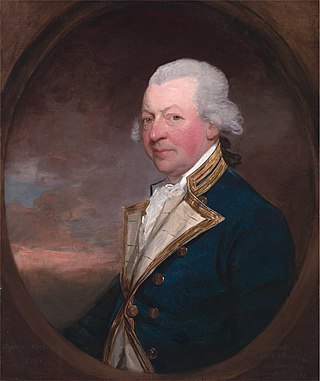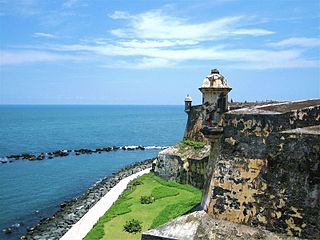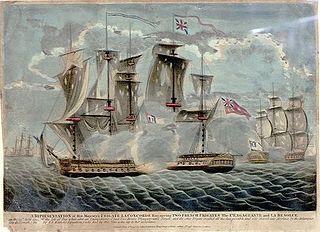Related Research Articles

Admiral Sir John Thomas Duckworth, 1st Baronet, GCB was an English officer of the Royal Navy, serving during the Seven Years' War, the American War of Independence, the French Revolutionary and Napoleonic wars, as the Governor of Newfoundland during the War of 1812, and a member of the British House of Commons during his semi-retirement. Duckworth, a vicar's son, achieved much in a naval career that began at the age of 11.

The Dardanelles operation was a failed assault by the British Royal Navy against the coastal fortifications of Constantinople. The operation was part of the Anglo-Turkish War.

Admiral Sir William Cornwallis, was a Royal Navy officer. He was the brother of Charles Cornwallis, 1st Marquess Cornwallis, British commander at the siege of Yorktown. Cornwallis took part in a number of decisive battles including the siege of Louisbourg in 1758, when he was 14, and the Battle of the Saintes but is best known as a friend of Lord Nelson and as the commander-in-chief of the Channel Fleet during the Napoleonic Wars. He is depicted in the Horatio Hornblower novel, Hornblower and the Hotspur.
John Elliot was a Scottish officer of the Royal Navy who served during the Seven Years' War and the American War of Independence. He rose to the rank of admiral, and served briefly as colonial governor of Newfoundland.

The Duncan class of 101-gun two-decker steam line-of-battle ships are considered by Professor Andrew Lambert to have been the "final statement of the British design progress" for steam two-deckers. The class consisted of HMS Duncan and HMS Gibraltar. The Bulwark class had identical hulls. HMS Gibraltar was the last wooden steam line-of-battleship to commission as a private ship in the Royal Navy.

John Rous was a Royal Navy officer and privateer. He served during King George's War and the French and Indian War. Rous was also the senior naval officer on the Nova Scotia station during Father Le Loutre's War. Rous' daughter Mary married Richard Bulkeley and is buried in the Old Burying Ground in Halifax, Nova Scotia.

James Richard Dacres was an officer of the Royal Navy who saw service during the Seven Years' War, the American War of Independence and the French Revolutionary and Napoleonic Wars. He eventually rose to the rank of Vice-Admiral.

Admiral of the Fleet Sir George Martin was an officer of the Royal Navy who saw service during the American War of Independence, and the French Revolutionary and Napoleonic Wars. During his long naval career he took part in several significant battles, for which he was awarded a number of honours and promotions; he commanded ships at Cape St Vincent and Cape Finisterre.

John MacBride was a British officer of the Royal Navy and a politician who saw service during the Seven Years' War, the American War of Independence and the French Revolutionary Wars, eventually rising to the rank of Admiral of the Blue.

The invasion of Cuba took place between 4–5 August and 9 December 1741 during the War of Jenkins' Ear. A combined army and naval force under the command of Admiral Edward Vernon and Major-General Thomas Wentworth arrived off Cuba and fortified positions around their landing site at Cumberland Bay. Despite facing no serious opposition, neither commander felt prepared to advance on the Spanish settlement at Santiago de Cuba. Harassed by Spanish raids and with a mounting sick list, the British finally evacuated the island after several months of inactivity.
Sir George Eyre was an officer of the Royal Navy who saw service during the American War of Independence and the French Revolutionary and Napoleonic Wars, eventually rising to the rank of Vice-Admiral of the Red.

Concorde was a 32-gun frigate of the French Navy, lead ship of her class. Built in Rochefort in 1777, she entered service with the French early in the American War of Independence and was soon in action, capturing HMS Minerva in the West Indies. She survived almost until near the end of the war when HMS Magnificent captured her in 1783. Not immediately brought into service due to the draw-down in the navy after the end of the war, Concorde underwent repairs and returned to active service with the outbreak of war with France in 1793 as the fifth-rate HMS Concorde.

Sir Thomas Pye was an admiral of the Royal Navy who served during the War of the Austrian Succession, the Seven Years' War, and the American War of Independence. He was briefly Member of Parliament for Rochester, and served as commander of several of the navy's principal stations and ports.

Hon. Charles Phipps was an officer in the Royal Navy. He served during the American War of Independence, seeing action in a number of battles and engagements. He also went on to have a career in Parliament sitting in the House of Commons from 1779 to 1786.
John Halsted was an officer of the Royal Navy who served during the American War of Independence and the French Revolutionary and Napoleonic Wars.

Rear-Admiral Thomas Lennox Frederick was an officer in the Royal Navy who served during the American War of Independence and the French Revolutionary Wars. He was a highly educated officer and a very greatly esteemed seaman, rising to the rank of rear-admiral of the red.
William Taylor was an officer in the Royal Navy who served during the American War of Independence and the French Revolutionary and Napoleonic Wars.

Admiral Sir Thomas Rich, 5th Baronet was a British naval officer and Member of Parliament.
Vice-Admiral Sir Charles Hardy, also known as Sir Charles Hardy the Elder, was a Royal Navy officer of the eighteenth century. Hardy entered the Royal Navy in 1695, joining his cousin Captain Thomas Hardy's ship HMS Pendennis. Promoted to lieutenant in 1701, he served in several ships of the line before being promoted to commander in 1705. Hardy commanded sloops in the English Channel, Mediterranean and North Seas, before taking command of HMS Dunwich in 1709, in which he was promoted to post captain. Hardy subsequently served for a year at Jamaica before commanding two ships during the Great Northern War between 1718 and 1720. Having changed commands several times, in 1727 he fought at the thirteenth siege of Gibraltar in HMS Kent.
References
- ↑ "Thomas Jordan". Three Decks – Warships in the Age of Sail.
- ↑ "Sons of the American Revolution". oatland.org. Retrieved 9 May 2015.